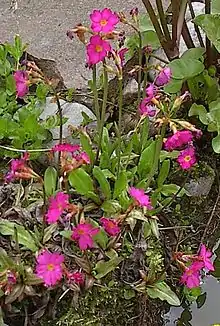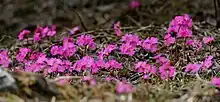Primula rosea
Primula rosea, the rosy primrose, is a flowering plant species in the genus Primula, native to the Himalayas. Growing to 50 cm (20 in) tall, it is a hardy herbaceous perennial with red-tinged leaves and clumps of rich pink flowers in spring.
| Primula rosea | |
|---|---|
 | |
| Scientific classification | |
| Kingdom: | Plantae |
| Clade: | Tracheophytes |
| Clade: | Angiosperms |
| Clade: | Eudicots |
| Clade: | Asterids |
| Order: | Ericales |
| Family: | Primulaceae |
| Genus: | Primula |
| Species: | P. rosea |
| Binomial name | |
| Primula rosea Royle Illustrations of the Botany of the Himalayan Mountains. 1(9):311. 1836; 2(4): t. 76, fig. 1. 1834 | |
In cultivation it prefers damp places such as the edge of a pond or stream, in moisture-retentive neutral or acid soil and full or partial sunlight. It has won the Royal Horticultural Society's Award of Garden Merit.[1]
Rosinidin is an anthocyanidin found in P. rosea.[2]
References
- "Primula rosea". www.rhs.org. Royal Horticultural Society. Retrieved 17 February 2021.
- The Structure and Distribution of the Flavonoids in Plants. Tsukasa Iwashina, Journal of Plant Research, 2000, Volume 113, Number 3, pages 287-299, doi:10.1007/PL00013940
This article is issued from Wikipedia. The text is licensed under Creative Commons - Attribution - Sharealike. Additional terms may apply for the media files.



